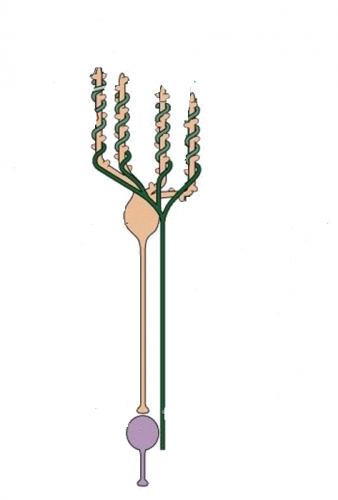The caudal portions of the cerebellar vermis (nodulus and uvula) together with the flocculus and paraflocculus (or tonsil) are part of the oldest portion of the cerebellum, the vestibulocerebellum.
The nodulus/uvula receives otolith inputs both directly from the labyrinth and indirectly via the vestibular nuclei1.
The nodulus and uvula are primarily important for control of rotational and translational VOR (r-VOR, and t-VOR), and for the control of spatial orientation using the velocity-storage mechanism2. Their output selectively encodes three-dimensional translation3.
As with lesions of the vestibulocerebellum (flocclus and paraflocculus), the following may be seen:
- Downbeat nystagmus also occurs with nodulus and uvular lesions, but its intensity does not change with vertical gaze position and it can be suppressed with visual fixation.
- Impairment of vertical pursuit (the effects on horizontal smooth tracking are not as striking)
Lesions of the nodulus and uvula are particularly associated with:
- Impairment in VOR gain
- Impairment in optokinetic nystagmus.
- Periodic Alternating Nystagmus

From: w-radiology.com. Photo gallery presents the anatomy of Cerebellum by means of MRI.http://w-radiology.com/cerebellum.php
The nodulus/ventral uvula act upon the “low-frequency” (sustained) components of the VOR via projections to the velocity storage mechanism within the vestibular nuclei.
With constant velocity rotation of the head, the velocity-storage mechanism extends the duration of the VOR response beyond that expected from the mechanical properties of the cupula–endolymph system within the semicircular canals. This results in improvement of the performance of the horizontal VOR at low frequencies of rotation, and extends the “bandwidth” of frequencies over which the horizontal VOR can transduce the motion of the head into the correct compensatory eye movement.
The velocity storage mechanism also serves an orienting function so the brain can know the position of the head relative to the pull of gravity, as well as determine whether a sensed linear acceleration of the head is from gravity or an imposed translation of the head.
The effect of lesions of the nodulus/uvula is to alter the velocity-storage mechanism:
- Horizontal VOR: increases the duration of vestibular responses to a constant-velocity input around an earth-vertical axis
- The vertical and torsional VOR is the opposite: time constants are shortened
Emphasizing the differences between horizontal and vertical VOR, the nodulus/uvula are also important for the processing of otolith signals from both the utricle and saccule to drive the t-VOR response. They are involved in the integration of linear head acceleration signals to velocity signals derived from otolith afferents. Ablation of the nodulus/uvula in monkeys impairs the ocular response to vertical translation.
Optokinetic Reflex
Optokinetic after-nystagmus shares the same velocity-storage mechanism with the VOR; after lesions of the nodulus/uvula, analogous to the VOR responses described above, horizontal OKAN is prolonged but the vertical and torsional OKAN response times are shortened.
Periodic alternating nystagmus (PAN)
This is a primary position horizontal nystagmus that changes direction in a crescendo–decrescendo fashion, characteristically every 90-120 seconds, with a null period of 0–10 seconds between each directional change.
PAN is not typically affected by visual fixation, and may be assoicated with periodic alternating head turns4. The nystagmus does follow Alexander’s law: nystagmus intensity increases on gaze in the direction of the quick phase5.
Subjects may have periodic alternating head-turn to minimize nystagmus (ie, head turn toward the direction of quick phases)5.
Causes include:
Congenital (may occur in albinism)
Various lesions at the brainstem and cranio-cervical junction (Arnold-Chiari malformation), in particular, of the nodulus of the cerebellum; cerebellar degeneration; multiple sclerosis; tumours. There is instability of the normal velocity storage mechanisms due to loss of GABA-mediated inhibition from the Purkinje cells of the nodulus onto the vestibular nuclei.
Anticonvulsant intoxication.
Treatment: Baclofen has been shown to be effective in PAN and the response is usually dramatic6.
(vv)PAN.mp4(tt)
(vv)PANZee.mp4(tt)
From: Zee DS. The cerebellum for the neuro-ophthalmologist: A video tutorial of some signs and syndromes to recognize NANOS 42nd Annual Meeting 2016. Retrieved from: https://collections.lib.utah.edu/ark:/87278/s6nw2r5g

